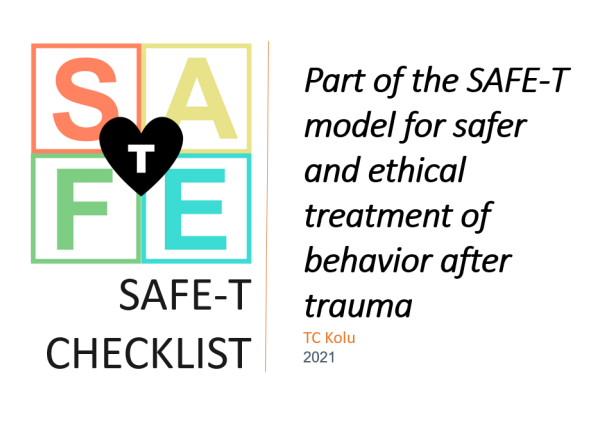Tags
behavior analysis, behavior analysis CEU, CEU, continuing education, cuspemergence, CuspEmergenceUniversity, ethics ceu, SAFE-T, SAFE-T Assessment, SAFE-T model, SAFET Model, supervision CEU, TI-ABA, TIABA, TIBA, trauma, trauma CEU, trauma-informed behavior analysis
It’s finally here! We have learned so much from workshop attendees, trainees and supervisees in this area over the past several years, and appreciate the attendance, feedback and support of everyone who has taken the training or used a version of the SAFE-T Assessment. Coming on Monday, the booklet and training for assessing trauma-related factors affecting our clients of behavioral services, are available ONLINE as a self-paced course. This course provides a download of the new and expanded SAFE-T Checklist booklet, which contains several tools enabling the screening and documentation of over 200 trauma-related factors, and a Risks and Needs form to help teams understand (and document) how these factors confer risks (and converge in risk factors that must be solved or mitigated to protect our clients, teams, and ourselves). The booklet contains an extensive reference section and team supportive tools as you use your new knowledge to better align your team’s skillset with the Ethics Code, and the individualized needs of behavior services clients after trauma.
Several of our behavior analytic and collaborator clients across institutions, educational facilities and private companies clients have shared that learning to assess risk factors related to trauma, and to apply this information to their teams’ FBAs and risk mitigation plans, took their skillset to the next level – essentially affording them an opportunity to acquire an important behavioral cusp for their teams.
Some new components of the booklet include:
- An optional buffer/ resilience score to assess whether protective environmental and therapeutic components of a client’s plan are in place (to understand some ways that trauma gives rise to medical and behavioral challenges and some buffering factors that can help, please see the book or scholarly articles by Dr. Nadine Burke Harris (e.g., Oh D.L. et al. 2018), who is the Presidential Scholar for 2021’s upcoming Association for Behavior Analysis International’s conference. She will address the critical topic of breaking the intergenerational cycle of adversity, and screening for ACES (adverse childhood experiences).
- Table of potentially contraindicated procedures (cross referenced with items and risk clusters assessed in the Risks and Needs form)
- Information about over 50 risk clusters (groups of related risks in the 6 assessed sections of the SAFE-T Assessment)
- Cross-reference tables showing, for each item we screen for, the location(s) in the SAFE-T Checklist
- Infographic on components of a trauma-informed FBA
- Brief templates for Risk Versus Benefit Analysis and Risk Mitigation Planning
- The IPASS (Inventory of Potential Aversive Stimuli and Setting Events) tool and instructions
- References (organized by topics) covering over 40 areas or topics of literature related to trauma (including relationships of ACES to medical problems, ACT and intellectual disability, ACT and anxiety, foster care and adoption, the relationship of abuse to pain, drug use and trauma, and much more).
Time required: The course includes about 4.5 hours of video content in 12 lessons, each followed by a brief quiz.
Price (includes 4.5 CEU course and SAFE-T Assessment booklet download): $189.99
For $20 off through the end of February, use the coupon code “SAFET20”.
To register: cusp.university

